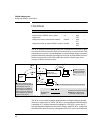
4-4
TACACS+ Authentication
Configuring TACACS+ on the Switch
• Local Authentication: This method uses username/password
pairs configured locally on the switch; one pair each for manager-
level and operator-level access to the switch. You can assign local
usernames and passwords through the CLI or web browser inter-
face. (Using the menu interface you can assign a local password,
but not a username.) Because this method assigns passwords to
the switch instead of to individuals who access the switch, you
must distribute the password information on each switch to
everyone who needs to access the switch, and you must configure
and manage password protection on a per-switch basis. (For
more on local authentication, refer to “Configuring Username
and Password Security” on page 2-1.)
• TACACS+ Authentication: This method enables you to use a
TACACS+ server in your network to assign a unique password,
user name, and privilege level to each individual or group who
needs access to one or more switches or other TACACS-aware
devices. This allows you to administer primary authentication
from a central server, and to do so with more options than you
have when using only local authentication. (You will still need to
use local authentication as a backup if your TACACS+ servers
become unavailable.) This means, for example, that you can use
a central TACACS+ server to grant, change, or deny access to a
specific individual on a specific switch instead of having to
change local user name and password assignments on the switch
itself, and then have to notify other users of the change.


















